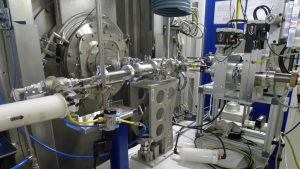A new method for the in-situ aerosol particle analysis by synchrotron light
|Small airborne particles, also called aerosol particles, may seem irrelevant if compared with entire ecosystems. However, they are strictly connected to a plethora of natural phenomena. For instance, they can influence the colouring of the sky, the visibility, and even clouds and ice formation. At the same time, they’re strongly affected by the direction and the intensity of the winds. More recently, it has also been highlighted how particles, such as the so-called PM10 and PM2.5, can affect health.
Thanks to the scientific and technological advancement, we’re more aware of the consequences of particulate air pollution on health and the environment. Despite the tremendous progress, current analytical techniques still require aerosol particles to be removed from their original context, thus having a profound and yet insufficiently characterised impact on final results. Therefore, being capable of analysing aerosol particles in their natural environment would deliver a significant impact.
A research published in Nature Communications, authored by Professor Paul Winkler (University of Vienna), Dr. Paulus Bauer (University of Vienna), Professor Heinz Amenitsch (Graz University of Technology) and colleagues, opened new ways for aerosol particle analysis through synchrotron light. Scientists employed small-angle X-ray scattering (SAXS), available at the Austrian CERIC Partner Facility at the synchrotron Elettra in Trieste, commonly employed in fields like material science and biochemical process analysis. In this case, it allowed for the study of aerosol particles in the gas phase.

A peculiarity of this study is the multi-step method employed for the correction of the instrument’s background signal. A pure gas constantly flowed through a tube reactor, while nanoparticles were introduced through an injection valve. The signal was collected in a seven-steps procedure, starting and finishing with pure gas, which constitutes the background. Nanoparticles were flowed-in and washed-out in the middle steps.
The following tests also involved the Transmission Electron Microscope (TEM), which helped in validating the data. The collected images, in fact, supported the statistical results obtained by SAXS.
This study demonstrates that the SAXS technique is suitable for the characterisation of aerosolised nanoparticles. This method will eventually allow for in-situ analysis of nanoparticles in real atmospheric conditions.



